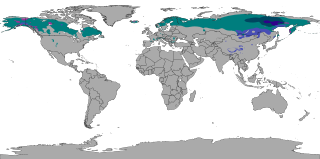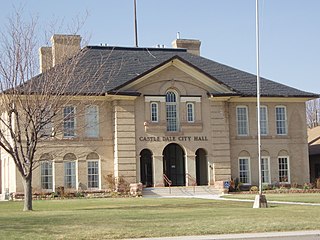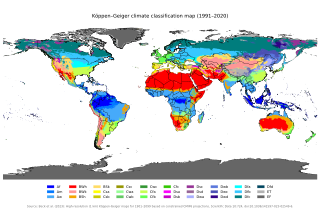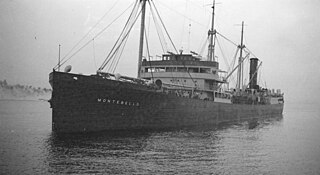This article needs additional citations for verification .(January 2017) |
| |||||
| Decades: | |||||
|---|---|---|---|---|---|
| See also: | |||||
The following lists events that happened during 1924 in Chile.
This article needs additional citations for verification .(January 2017) |
| |||||
| Decades: | |||||
|---|---|---|---|---|---|
| See also: | |||||
The following lists events that happened during 1924 in Chile.

The subarctic climate is a continental climate with long, cold winters, and short, warm to cool summers. It is found on large landmasses, often away from the moderating effects of an ocean, generally at latitudes from 50°N to 70°N, poleward of the humid continental climates. Subarctic or boreal climates are the source regions for the cold air that affects temperate latitudes to the south in winter. These climates represent Köppen climate classification Dfc, Dwc, Dsc, Dfd, Dwd and Dsd.

Meiners Oaks is an unincorporated community lying west of the city of Ojai in Ventura County, California, United States. The population was 3,571 at the 2010 census. For statistical purposes, the United States Census Bureau has defined Meiners Oaks as a census-designated place (CDP).

Moro is a city in Sherman County, Oregon, United States. The population was 324 at the 2010 census. It is the county seat of Sherman County. It’s currently the least-populous county seat in Oregon. Moro was incorporated on February 17, 1899, by the Oregon Legislative Assembly. It was named for Moro, Illinois.

Castle Dale is a city in northwestern Emery County, Utah, United States. The population was 1,492 at the 2020 census. It is the county seat of Emery County.

A rain shadow is an area of significantly reduced rainfall behind a mountainous region, on the side facing away from prevailing winds, known as its leeward side.

The Köppen climate classification is one of the most widely used climate classification systems. It was first published by German-Russian climatologist Wladimir Köppen (1846–1940) in 1884, with several later modifications by Köppen, notably in 1918 and 1936. Later, German climatologist Rudolf Geiger (1894–1981) introduced some changes to the classification system in 1954 and 1961, which is thus sometimes called the Köppen–Geiger climate classification.
The following lists events that happened during 1923 in Australia.
The following lists events that happened during 1902 in Australia.

Bahrain is a town located in Swat District of Khyber Pakhtunkhwa, Pakistan, 60 km north of Mingora at an elevation of 4,700 ft on the right bank of the Swat river. It is named Bahrain due to its location at the confluence of the Daral and Swat rivers. It is known for its riverside tourist resorts, local handicrafts, and its view of the merging of the Daral and Swat rivers. It also serves as a base camp for the trail that leads to the Daral and Saidgai lakes.

Tsesarevich was a pre-dreadnought battleship of the Imperial Russian Navy, built in France at the end of the 19th century. The ship's design formed the basis of the Russian-built Borodino-class battleships. She was based at Port Arthur, northeast China, after entering service and fought in the Russo-Japanese War of 1904–1905. Tsesarevich was torpedoed during the surprise attack on Port Arthur and was repaired to become the flagship of Rear Admiral Wilgelm Vitgeft in the Battle of the Yellow Sea and was interned in Qingdao after the battle.

Central Chile is one of the five natural regions into which CORFO divided continental Chile in 1950. It is home to a majority of the Chilean population and includes the three largest metropolitan areas—Santiago, Valparaíso, and Concepción. It extends from 32° south latitude to 37° south latitude.

Hisor or Hisar is a city in western Tajikistan, about 15 km west of Dushanbe. The city was the seat of the former Hisar District, and is part of the Districts of Republican Subordination. It lies at an altitude of 799–824 m, surrounded by high mountains. The river Khanaka, a tributary to the Kofarnihon, flows through the town. Its population is estimated at 29,100 for the city proper and 308,100 for the city with the outlying communities (2020). As of 2002, its population was composed 81.6% of Tajiks, 12.3% Uzbeks, 3.6% Russians, and 2.5% others.

The Atacama Desert is a desert plateau located on the Pacific coast of South America, in the north of Chile. Stretching over a 1,600-kilometre-long (1,000-mile) strip of land west of the Andes Mountains, it covers an area of 105,000 km2 (41,000 sq mi), which increases to 128,000 km2 (49,000 sq mi) if the barren lower slopes of the Andes are included.

Roghun is a city in Tajikistan. The city was the seat of the former Roghun District, and is part of the Districts of Republican Subordination. Its population is estimated at 14,900 for the city proper and 44,100 for the city with the outlying communities (2020).

Montebello was a steam oil tanker built in 1920–1921 by the Southwestern Shipbuilding Co. of San Pedro for Union Oil Company. It was designed to carry oil and petroleum products along the West Coast of the United States and Canada, as well as between the United States and Chile. In December 1941 the tanker was sunk on one of her regular trips by the Japanese submarine I-21.
Takliwa was a 7,936 GRT cargo liner that was built in 1924 by Barclay, Curle & Co Ltd, Glasgow, Scotland for the British India Steam Navigation Company. She was converted to a hospital ship during the Second World War, serving until she was wrecked in October 1945.
The England and Wales Precipitation (EWP) record is a historical meteorological dataset which was originally published in the journal British Rainfall in 1931 and updated in a greatly revised form by a number of climatologists including Janice Lough, Tom Wigley and Phil Jones during the 1970s and 1980s. The monthly mean rainfall and snowfall for the region of England and Wales are given from the year 1766 to the present, though the original 1931 dataset went as far back as 1727.
The following lists events that happened during 1900 in Chile.

Paposo or Caleta Paposo is a hamlet in the southern part of Antofagasta Province, Chile. It is located on a narrow coastal plain bordering the Pacific Ocean. The census of 2002 counted 259 inhabitants, who predominantly relied on fishing and mining for a living. Paposo has a desert climate, but "fog oases" exist on mountain slopes near the sea. In a region almost devoid of vegetation, these oases, also called lomas, support a variety of flora found from about 1 km (0.62 mi) to 4 km (2.5 mi) inland.
Promops davisoni is a species of free-tailed bat in the family Molossidae. It was first described by Oldfield Thomas in 1921. While thought of as a subspecies of the big crested mastiff bat by scientists from roughly 1966 to 2010, morphological and geographical differences between P. davisoni and P. centralis are sufficiently suggestive of another species. P. davisoni is small for its genus, with a forearm length of 47.6 to 52.0 millimetres, and is light or cinnamon brown with distinguishable white bands on its back. P. davisoni is native to the Andes mountain range in Ecuador and Peru. More recently, evidence has been found that P. davisoni resides in the Atacama Desert in Chile.